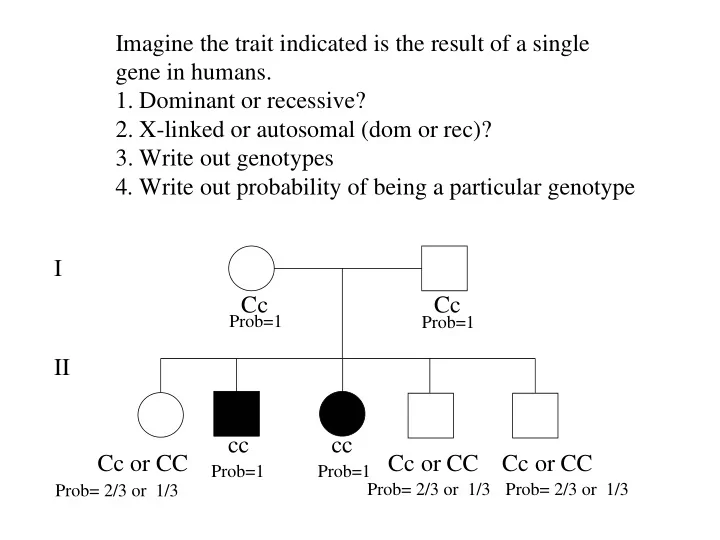

Imagine the trait indicated is the result of a single gene in humans. 1. Dominant or recessive? 2. X-linked or autosomal (dom or rec)? 3. Write out genotypes 4. Write out probability of being a particular genotype I Cc Cc Prob=1 Prob=1 II cc cc Cc or CC Cc or CC Cc or CC Prob=1 Prob=1 Prob= 2/3 or 1/3 Prob= 2/3 or 1/3 Prob= 2/3 or 1/3
Why CC 1/3 prob and Cc 2/3 prob? 1/2 C 1/2 c 1/2 C 1/4 CC 1/4Cc 1/2 c 1/4 Cc 1/4cc _________________________ In total we expect 1/4CC : 2/4 Cc : 1/4 cc But we know the non-affected progeny are not cc so that genotype is irrelevant. So this leaves 1 CC: 2 Cc or 1/3 CC : 2/3 Cc Note that this often confuses people, so think carefully ensure you understand why this is. Essentially the reason is that you have information on the phenotype, so one phenotypic class can be thrown out.
This pedigree is the result of a rare single gene trait in Humans Dom or Rec? X-linked or Autosomal? Write out genotypes and probabilities I Dd dd II Dd Dd Dd dd dd dd dd III dd dd dd Etc.
Another rare single gene trait in Humans. X B Y X b X b X b X B X b Y X b X B X b Y X b Y X B X B because rare X B Y X B Y X B Y X b X B Etc.
There are very few known Y-linked traits. What would one look like. Hairy ears may be one such trait. Transmission occurs only from father to son. X Y h X X X Y h X Y h X Y h X X X X
Estimating risks in pedigree analysis One value of constructing pedigrees in humans is for genetic disorders where the inheritance is known, is that we can provide estimates of the probability that a particular couple might have a child with a particular disorder. PKU is an autosomal recessive disorder (pp). What is the probability that the next child of the couple indicated will have PKU? ?
We know PKU results from autosomal recessive allele (p). 1. Write out genotypes and their associated probabilities. Pp Pp Prob=1 Prob=1 ? pp Prob=1 What’s probability next child has disease? From Pp x Pp mating, 1/4 are pp so probability = 1/4.
A more difficult example. Imagine this is the pedigree for Tay sachs disease, also a debilitating autosomal recessive (tt) disorder involving a defect in the enzyme hexosaminidase A that is involved in fat metabolism. What is the probability that the first child of the mating indicating would have the disorder? ?
1. First write out genotypes known with certainty. 2. In order for the mating shown to produce an affected child both parents must be heterozygous, so write out the probability that each is heterozygous 3. If the couple shown are both heterozgous, what is the probability their first child will have the disease? Prob=1/4 Tt Tt Tt Tt tt Tt Tt tt prob=2/3 prob=2/3 ?
Tt Tt Tt Tt tt Tt Tt tt prob=2/3 prob=2/3 ? But the parents aren’t necessarily Tt, each has a 2/3 chance. So we must take this into account in our assessment by multiplying the independent probabilities. If the mother is Tt AND father is Tt then child has 1/4 chance of being tt. Prob 1st child is tt = 2/3 x 2/3 x 1/4 = 1/9 = 0.11 or ~11% chance that the first child will have Tay Sachs disease
For the same disease and pedigree, what is the probability that the first child will not have the disease? Tt Tt Tt Tt tt Tt Tt tt prob=2/3 prob=2/3 ? The “easy” way to do this, is first to calculate the probability that the child will have the disease (as we just did) and subtract that value from 1. Prob (1st child doesn’t have disease) = 1-1/9 = 8/9 or ~89%
Tt Tt Tt Tt tt tt ? To work out the more cumbersome approach, you need to consider all the ways in which normal offspring might arise. Then calculate the probability for each of those ways, and then add them all up. So secenario 1. Male TT x Female TT. all children normal = 1/3 x 1/3 x 1 = 1/9 or Male Tt x Female TT; all children normal = 2/3 x 1/3 x 1 = 2/9 or Male TT x Female Tt, all children normal = 1/3 x 2/3 x 1 = 2/9 or Male Tt x Female Tt, 3/4 children normal = 2/3 x 2/3 x 3/4 = 3/9 Total = 8/9
Recommend
More recommend